How to check the RCD for operability: methods for checking the technical condition
The residual current device (RCD) can be safely ranked among the devices that should be in every home. Such an apparatus is capable of signaling a current leak and, accordingly, rescuing residents from fire and electrical injuries.
However, in order to be completely confident in the protection, it is advisable to be aware of how to independently check the RCD and make sure that it is working.
In this material we will tell you what an RCD is, give the main characteristics of this device, and also give some simple ways to check the device for performance.
The content of the article:
What is an RCD?
The correct name for the RCD is an automatic, differential current controlled circuit breaker. This switching device serves to automatically interrupt the circuit when exceeding the set digits of the unbalance current arising under certain conditions.
The operation of the internal mechanism of the apparatus is based on the following rules: the neutral and phase conductors are connected to the terminals, and then they are compared by current. In the normal state of the entire system, there is no difference between the phase current strength and the neutral conductor data. Her appearance indicates a leak. After analyzing the abnormal condition, the device turns off.
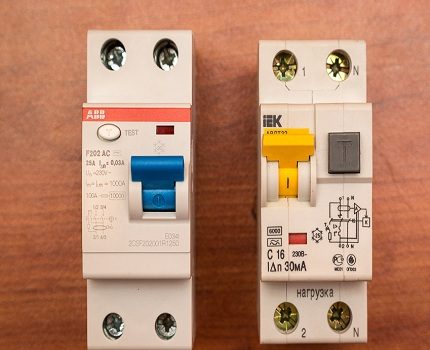
In simpler terms, an RCD trips and breaks the network when the current begins to flow outside the wiring or devices connected to the mains.
In those circuits in which leaks are possible and the possibility of electric shock to people is most likely set the RCD. In a house or apartment, these are places where vapors accumulate, thereby causing high humidity. It has a kitchen and a bathroom. In addition, it is these rooms that are the most saturated with all kinds of electrical appliances.
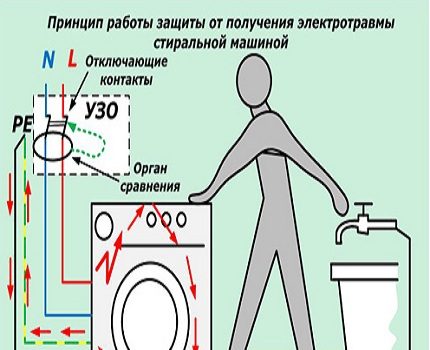
One of the usual electrical assistants can shock a person with a current when it is not possible to ground it or this is not taken into account in the design. When, in one of the devices, the insulation of the lead wires is violated, current will flow to the unit body.
In the absence of grounding, when you touch such a surface, a person will receive an electric shock. To prevent this from happening and you need to install a protective shutdown device.
RCD designs may vary in mode of action. Manufacturers produce devices that have an auxiliary power source for the normal operation of the electronic circuit and devices that do without it.
Electromechanical protective devices operate directly from the leakage current, using the potential of a pre-charged mechanical spring. The operation of RCDs on electronic components is completely dependent on the presence of voltage in the network. To disconnect, he needs additional power. In this regard, the latter device is considered less reliable.
Characteristics of the protective device
On sale you can find a lot of different models of residual current circuit breakers. Between themselves, they differ in production standards, installation method and scope of use.
Wrong choice of protection device can lead to the following troubles:
- The device will constantly respond in response to the slightest leaks that are present in the electrical network of each house.
- If a device with oversized characteristics was selected upon purchase, it may not respond to an emergency. As a result, there is a high probability of electrical injury.
To avoid such incidents, you must study RCD characteristics. You can read them by special markings on the device.
Rated load current
This is one of the most important characteristics. The figure indicates the maximum value of the current that can pass through the device for a long time, without causing any harm to it. The magnitude of the immunity of power contacts and conductors of a certain load is determined. However, they remain in working condition.

The rated currents are typical for all models: 16 A, 25 A, 40 A, 63 A, 80 A, 100 A, 125 A.
What is the tripping current?
It can be said that this is the most important parameter. It indicates the leakage current at which the protection is activated and the device turns off. On the case, this value is indicated by the symbols IΔn. Standard settings for rated differential current from 6 mA to 500 mA.
Each of the values indicates where exactly the apparatus can be used. For example, a device with an IΔn of 500 mA cannot protect a person from electrical injury.
Non-breaking rated differential current
This parameter characterizes the threshold of the device. Designate it as IΔn0.The value is always equal to half the current of the nominal differential tripping (IΔn), that is, a device with a value of 10 mA is cut off during a current leak of 5 mA.
If a leakage current less than this indicator flows through the protective device, the device will not operate.
RCD trip time
This value indicates the reaction rate of the protective device in an emergency. The rated RCD trip time is indicated by Tn. Norm - a maximum of 0.3 seconds. High-quality modern protection devices work in 0.1 seconds, but such a high speed is unclaimed.
Types of devices: AC - the device is triggered when the instantaneous occurrence of alternating current; A - with alternating or pulsating current; B - with constant, straightened and variable; S - a certain time is maintained before operation (0.15-0.5 seconds); G - the exposure time is less than the previous one (0.06-0.08 sec).
The reasons for the operation of the device
There are a lot of reasons for the network disconnection by the protection device, but only after their identification can the problems be completely eliminated.
Moreover, to find a problem place, in order to avoid serious consequences, you need to try as soon as possible.
Reason # 1 - Current Leak
A network leak occurs most often in the case of old wiring. Over time, the insulation is dry and some of its sections are exposed. The same problem can occur after replacing the old wiring with a new one, when the connection was poorly made.

The third, quite common cause, can be called an accidental damage to hidden wiring. For example, driving a nail into a wall.
Reason # 2 - ground fault and zero
The rules of the PUE are forbidden to combine neutral conductors and grounding. However, some negligent masters reject the existing “taboos” and do their own thing, despite the fact that in this way the threat of electric shock to people is greatly increased.
Reason # 3 - inclement weather
Weather can significantly affect the performance of the protective device when the switchboard is located outside the premises, that is, on the street. Due to the appearance of the smallest particles of water inside the structure, the device may trigger.
If the street is cold, the protection device, on the contrary, may not perform its functions. This is due to the fact that low temperatures adversely affect microcircuits and can completely disable them.
There are known cases of power outages by protective devices during thunderstorms. Lightning can amplify even the very slight leaks present in the house.
Reason # 4 - improper installation of the device itself
Such an incident as a false shutdown may occur periodically due to improper installation of the protective device.
Therefore, it is advisable to independently engage in installation only after a thorough study of the instructions. Incorrect selection of characteristics when buying can also be attributed to this.
Reason # 5 - malfunctions in household appliances
The failure of the cord, through which the household appliance is connected to the network, causes the instantaneous operation of the protective device.
This also happens when current leaks from internal spare parts, for example, a heater in a water heater or the motor winding of any of the included devices.
Reason # 6 - Humidity
It happens that after the installation of hidden wiring, the track is covered with putty and immediately try to check the work done. In such cases, the protective device is triggered due to the environment of the wires with wet putty.
This is due to the ability of water to provoke leakage through microscopic cracks and other insulation defects.If you wait until the filler material is completely dry and repeat the manipulation, most likely, the shutdown will not happen again.
Check RCD for operability
To feel safe, you should regularly, at least once a month, arrange a check of the protective device.
You can do this yourself at home. All known verification methods are quite simple and affordable.
Method number 1 - test using the TEST button
The button for testing is located on the front panel of the device and is marked with the letter "T". When it is pressed, a leak is simulated and protective mechanisms are activated. As a result, the device breaks the power.
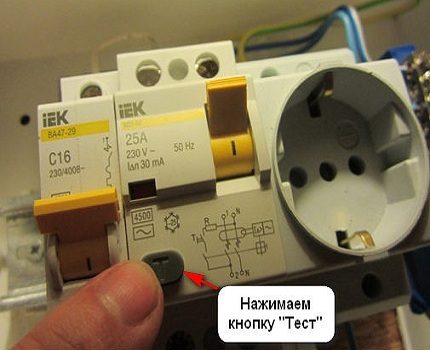
However, under certain conditions, an RCD may not work:
- Incorrect device connection. A thorough study of the instructions and reconnecting the device according to all the rules will help to correct the situation.
- The TEST button itself is faulty, that is, the device is operating normally, but a leak simulation does not occur. In this case, even with proper installation, the RCD will not respond to testing.
- Malfunctions in automation.
The last two versions can only be confirmed using alternative verification methods.
To verify the reliability of the test mechanism, repeat the button 5-6 times. At the same time, after each network shutdown, one must not forget to return the control key to the initial position (“On,” state).
Method number 2 - battery check
The second simple way, as you can test the RCD yourself in the home for performance, is to use a finger-type battery familiar to everyone.
Such testing can only be carried out with a protection device with a rating of 10 to 30 mA. If the device is designed for 100-300 mA, RCD operation will not occur.
Using this technique, perform the following steps:
- 1.5 - 9 Volts batteries are connected to each pole of the battery.
- One wire is connected to the input of the phase, the other to its output.
As a result of these manipulations, a working RCD will turn off. The same thing should happen if the battery is connected to the zero input and output.

Before arranging such an audit, it is necessary to study the characteristics of the device. If the unit is marked A, it can be checked with a battery of any polarity. When checking the AC protective device, the device will respond in only one case. Therefore, if no tripping occurs during the test, the polarity of the contacts should be changed.
Method number 3 - the use of an incandescent bulb
Another surefire way to monitor the effectiveness of a protective device is with a light bulb.
To complete it, you will need:
- a piece of electrical wire;
- incandescent lamp;
- cartridge;
- resistor;
- screwdrivers;
- insulating tape.
In addition to the items listed, a tool can be useful with which you can easily remove the insulation. You can read about the best wire strippers in this stuff.
Incandescent lamps and resistors planned for testing must necessarily have suitable characteristics, because the RCD reacts to certain numbers. Most often, the protective device that is purchased for installation in a house or apartment is designed to respond to a leak of 30 mA.
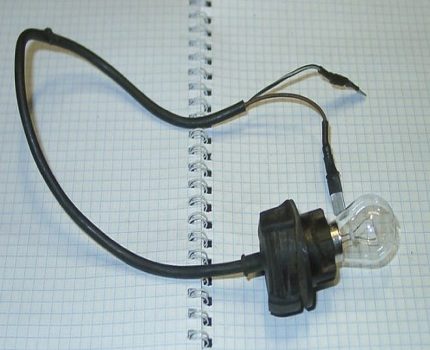
The desired resistance is calculated by the formula:
R = U / I,
where U is the voltage in the network, and I is the differential current for which the RCD is designed (in this case, 30 mA).The result is: 230 / 0.03 = 7700 ohms.
A 10 W incandescent lamp has a resistance of approximately 5350 ohms. To get the desired figure, it remains to add another 2350 ohms. It is with this value that you need a resistor in this circuit.
After selecting the required elements, the circuit is assembled and, performing the following manipulations, check the operation of the RCD:
- One end of the wire is inserted into the outlet phase.
- The second end is applied to the ground terminal in the same outlet.
During normal operation, the safety device knocks it out.
If there is no grounding in the house, the test procedure changes slightly. On the input shield, namely in the place where the automation is located, insert the wire into the zero input terminal (marked N and is located on top). Its second end is inserted into the phase output terminal (labeled L and located at the bottom). If everything is normal with an RCD, it will work.
Method number 4 - tester check
The method of checking the health of the protection device using special ammeter or multimeter devices is also used at home.
For its implementation you will need:
- light bulb (10 W);
- rheostat;
- resistor (2 kOhm);
- wires.
Instead of a rheostat, you can use Dimmer. He is endowed with a similar principle of action.
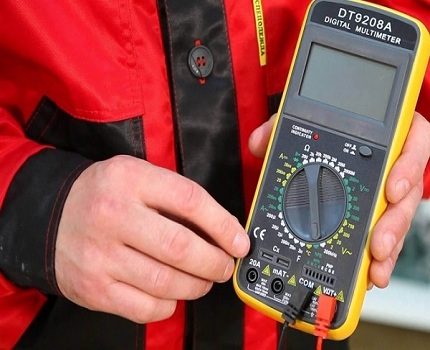
The circuit is assembled in the following sequence: ammeter - bulb - resistor - rheostat. The ammeter probe is connected to the zero input in the protective device, and the wire is connected from the rheostat to the phase output.
Then slowly turn the rheostat control in the direction of increasing current leakage. When the protection device trips, the ammeter will record the leakage current.
Conclusions and useful video on the topic
Checking the RCD for triggering using simple tools at hand:
From this video you can learn about how to test an RCD using a battery:
Having studied the recommendations in detail, you can choose the best option for yourself and regularly conduct monitoring yourself. Only in this case can you be completely sure that no one at home will be injured by electric shock.
If you have questions about the topic of the article, you can ask them in the comment box. Maybe you know other ways to check the RCD for operability? Tell our readers about them.

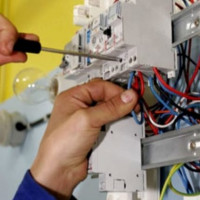 RCD for a water heater: selection criteria + schemes and connection rules
RCD for a water heater: selection criteria + schemes and connection rules  Why does an RCD knock out: causes of operation and troubleshooting
Why does an RCD knock out: causes of operation and troubleshooting  Fire RCD: selection recommendations, rules and installation diagrams
Fire RCD: selection recommendations, rules and installation diagrams  How to connect a differential machine: possible connection schemes + step-by-step instructions
How to connect a differential machine: possible connection schemes + step-by-step instructions 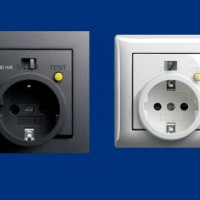 Socket with built-in RCD: device, connection diagram, recommendations for selection and installation
Socket with built-in RCD: device, connection diagram, recommendations for selection and installation 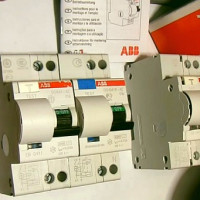 How to choose the right RCD by capacity: existing types of RCD + subtleties of choice
How to choose the right RCD by capacity: existing types of RCD + subtleties of choice  How much does it cost to connect gas to a private house: the price of organizing gas supply
How much does it cost to connect gas to a private house: the price of organizing gas supply  The best washing machines with dryer: model rating and customer tips
The best washing machines with dryer: model rating and customer tips  What is the color temperature of light and the nuances of choosing the temperature of the lamps to suit your needs
What is the color temperature of light and the nuances of choosing the temperature of the lamps to suit your needs  Replacement of a geyser in an apartment: replacement paperwork + basic norms and requirements
Replacement of a geyser in an apartment: replacement paperwork + basic norms and requirements
Well, not every person can find a tester at home, but it’s silly to buy it specifically to use it once and check it. Therefore, the first three methods of verification will be more relevant. I didn’t have to act with the battery, I didn’t know about such an option, but with the help of an incandescent lamp it’s quite possible to check it myself, there’s nothing complicated there. Everything is clear with the test button, usually it is generally marked in orange.
Good day, Sergey. Of course, the methods disclosed in the article are useful. True, in such ways it turns out "does the RCD work at all." Agree, even the tester does not record the time of occurrence of malicious current and the time of the circuit breaking by RCD contacts. Only by fixing this period of time, you can judge the usefulness of the protective function.
For example, the Krasnodar Electric Laboratory uses the PZO 500 device, which even establishes the initial phase of the occurrence of a "dangerous current". “Malicious current” is generated by the microprocessor - it provides a smooth increase, fixes the current, which should cause a trip, records the response time. To understand the complexity of the verification, I attached a screenshot of the Instructions page.
Regarding the frequency of testing - PUE recommends following the operational documentation of the device. RCD tests are usually combined with tests of the corresponding network. Testing with the “Test” button is charged to operational personnel - the “monthly test” often appears here.